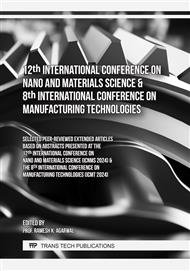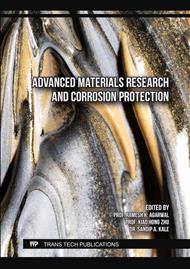p.3
p.11
p.19
p.29
p.35
p.43
p.51
p.59
p.69
Investigation of the Mechanical Properties of Urethane Dimethacrylate (UDMA) Reinforced with Abaca Cellulose for Vat Photopolymerization (VP)
Abstract:
Additive manufacturing (AM) was developed to cope with the demand for manufacturing goods. It ensures faster production and high waste reduction but is limited by material compatibility. One of the technologies in AM is Vat Photopolymerization (VP). It is a type of AM that uses photopolymer resin and UV light for polymerization. Various materials had been studied to improve the mechanical properties of the photopolymer resin by adding additives from indigenous sources. This study extracted cellulose from abaca and modified it by cross-linking it with Polyethylene Glycol (PEG). The cross-linked abaca cellulose (CAC) was investigated as an additive in the photopolymer resin with fiber loading of 3 wt.%, 6 wt.% and 9 wt.%. Fourier Transform-Infrared Spectroscopy (FT-IR) shows that the presence of the oxygenated functional groups in resin and CAC can interact to form hydrogen bonds. Thermogravimetric Analysis (TGA) showed better thermal stability with the addition of 9 wt.% CAC compared to pure UDMA. Furthermore, the glass transition (Tg) decreased with the addition of CAC by 8.29 °C. The Tensile Test showed that 3 wt.% of CAC resulted in the highest value for tensile strength and toughness with an 11.27% increase for tensile strength and 133.46% for toughness. The elastic modulus increased with fiber loadings and had increased by 48.51% at 9 wt.% of CAC. Based on the results, the effect of adding abaca cellulose into a UDMA based resin had improved the thermal stability and mechanical properties of the composites.
Info:
Periodical:
Pages:
35-40
Citation:
Online since:
June 2024
Price:
Сopyright:
© 2024 Trans Tech Publications Ltd. All Rights Reserved
Share:
Citation:



